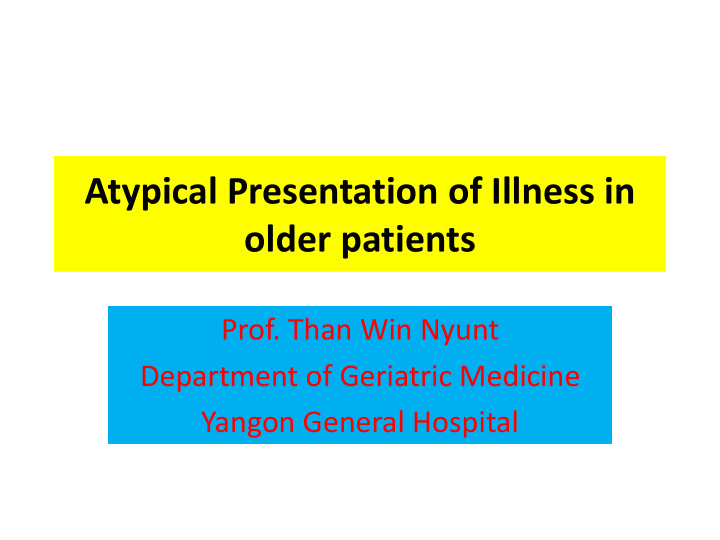



Atypical Presentation of Illness in older patients Prof. Than Win Nyunt Department of Geriatric Medicine Yangon General Hospital
Defining Atypical Presentations • The definition of an atypical presentation of illness is: when an older adult presents with a disease state that is missing some of the traditional core features of the illness usually seen in younger patients .
Risk Factors • Over age 85 in particular • Multiple co-morbidities • Multiple medications • Cognitive or functional impairment
Consequences (of not identifying) • Increased morbidity and mortality • Missed diagnosis • Unnecessary use of Emergency Rooms
Types of Atypical presentations (1) Vague Presentation of Illness; (2) Altered Presentation of Illness; and (3) Non-presentation (under-reporting) of Illness.
(1)Vague Presentation of Illness • Changes in behavior or function in an older adult are often a prodrome (symptoms(s) indicative of an approaching disease) of an acute illness, especially for frail older adults. • Mild confusion, changes in ability to perform activities of daily living (ADL), and decreased appetite.
Non-specific Symptoms that may Represent Specific Illness Confusion Self-neglect Falling Incontinence Apathy Anorexia Dyspnea Fatigue
(2)Altered Presentation of Illness Illness Atypical Presentation Infectious Absence of fever diseases Sepsis without usual leukocytosis and fever Falls, decreased appetite or fluid intake, confusion, change in functional status "Silent" acute Absence of symptoms (silent presentation) abdomen Mild discomfort and constipation Some tachypnea and possibly vague respiratory symptoms Silent" Back pain secondary to metastases from slow malignancy growing breast masses Silent masses of the bowel
Altered Presentation of Illness (2) Silent" Absence of chest pain myocardial Vague symptoms of fatigue, nausea and a infarction decrease in functional status. Shortness of breath more common complaint than chest pain Non-dyspneic May not subjectively experience the classic pulmonary symptoms such as paroxysmal nocturnal edema dyspnea or coughing Typical onset is insidious with change in function, food or fluid intake, or confusion Thyroid disease Hyperthyroidism presenting as "apathetic thyrotoxicosis," i.e. fatigue and a slowing down Hypothyroidism, presenting with confusion and agitation
Depression Lack of sadness Somatic complaints, such as appetite changes, vague GI symptoms, constipation, and sleep disturbances Hyper activity Sadness misinterpreted by provider as normal consequence of aging Medical problems that mask depression Medical Hypo- and hyper- thyroid disease that presents illness that as diminished energy and apathy presents as depression
(3) “ Hidden" Illness in Older Adults Depression Incontinence Musculoskeletal stiffness Falling Alcoholism Osteoporosis Hearing loss Dementia Dental Problems Poor nutrition Sexual dysfunction Osteoarthritis
Factors that contribute to the under-reporting of illnesses • The insidious nature of the onset of the illnesses and the vague symptoms associated with these problems • A tendency on the part of patients and families to regard many of these symptoms as a "normal" part of aging • Reluctance of older people to complain about problems because of concerns as to being ignored or generating burdensome tests • Communication deficits including hearing impairments, poor vision, and speech problems
Expected Outcomes (1) • Healthcare providers will: Use of a range of interventions to prevent, alleviate, or ameliorate altered presentation of illness in older adults Document and communicate each individual's altered presentation of illness on chart and between levels of care Increased their knowledge about altered presentation in the elderly
Expected Outcomes (2) • Institutions will: Provide educational material related to atypical presentation of illness See decreased morbidity and mortality due to atypical presentation of illness See improved documentation of altered presentation of illness Staff will receive ongoing education related to identification of altered presentation of illness
References Ham, R., Sloane,D. & Warshaw,G. (2002). Primary Care Geriatrics: A Case Based Approach . pp 32-33.St Louis, MO:Mosby. Reprinted with permission from Elsevier. Last updated - January 2005
Recommend
More recommend